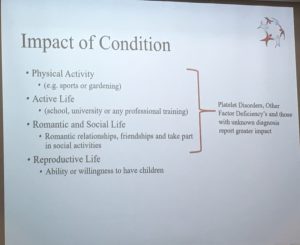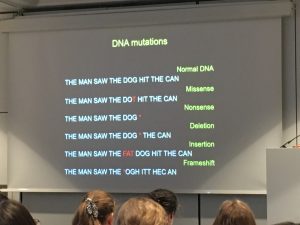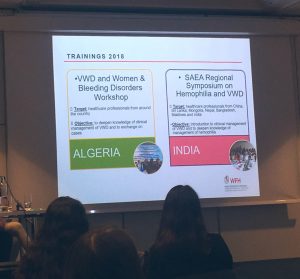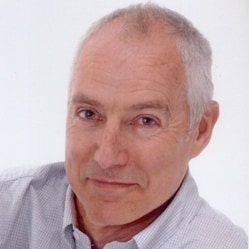The first ever EHC Conference on Women and Bleeding Disorders kicks off – Day 1
The first day of the EHC Conference on Women and Bleeding Disorders (WBD) lived up to the promise of a packed agenda, with five hours of presentations and discussion. EHC Chief Executive Amanda Bok warmly welcomed participants, pointing out this was the first international meeting with WBD at its heart – certainly in Europe and probably globally.
 Naja Skouw-Rasmussen, Chair of the EHC WBD Committee, summarised EHC’s recent survey of experience of WBD among women, member organisations and treatment centres. EHC had carried out the survey because WBD are not fully recognised and we need robust information about the impact of bleeding disorders on women to change misconceptions. It came as no surprise, Naja said, that bleeding disorders affect all aspects of life. They significantly affect a woman’s choices about having a family, regardless of severity. She reminded the audience that late diagnosis and heavy menstrual bleeding have a major impact and emphasised the need to talk more openly – especially about menstruation.
Naja Skouw-Rasmussen, Chair of the EHC WBD Committee, summarised EHC’s recent survey of experience of WBD among women, member organisations and treatment centres. EHC had carried out the survey because WBD are not fully recognised and we need robust information about the impact of bleeding disorders on women to change misconceptions. It came as no surprise, Naja said, that bleeding disorders affect all aspects of life. They significantly affect a woman’s choices about having a family, regardless of severity. She reminded the audience that late diagnosis and heavy menstrual bleeding have a major impact and emphasised the need to talk more openly – especially about menstruation.
That message was taken up by Michelle Lavin, Consultant Haematologist at the Irish Centre for Vascular Biology. She estimated there are probably 4.5 million women with a bleeding disorder in Europe. Heavy periods are therefore a major public health concern. Despite this, many families do not perceive this as an avoidable problem, assuming they are normal. With the added effects of disinterest among some in the medical profession, under-diagnosis and cultural taboos, many women needlessly endure debilitating symptoms throughout their lives. Some doctors still believe that haemophilia is a diagnosis for men, she added.
 The inheritance and transmission of haemophilia, von Willebrand disease (VWD) and rare bleeding disorders were reviewed by Consultant Haematologists Eugenia Biguzzi from Milan and Karin von Galen from Utrecht. This is a topic that comes with a ‘May Get Technical’ warning but the science was complemented by a discussion about genetic counselling. Rezan Kadir, Consultant Obstetrician and Gynaecologist from the UK, continued the theme with a review of invasive and non-invasive prenatal testing and diagnosis, and their merits at various stages of pregnancy. Detection of fetal DNA in maternal blood is looking like a promising option for early diagnosis.
The inheritance and transmission of haemophilia, von Willebrand disease (VWD) and rare bleeding disorders were reviewed by Consultant Haematologists Eugenia Biguzzi from Milan and Karin von Galen from Utrecht. This is a topic that comes with a ‘May Get Technical’ warning but the science was complemented by a discussion about genetic counselling. Rezan Kadir, Consultant Obstetrician and Gynaecologist from the UK, continued the theme with a review of invasive and non-invasive prenatal testing and diagnosis, and their merits at various stages of pregnancy. Detection of fetal DNA in maternal blood is looking like a promising option for early diagnosis.
 The third of the day’s sessions was devoted to the World Federation of Hemophilia’s (WFH) work to support WBD. WFH’s global surveys have demonstrated the extent to which the prevalence of bleeding disorders in women is underestimated in most countries and there are now many initiatives that aim to promote awareness and empower women locally. The obstacles are deeply embedded – for example, the habit of describing women as ‘carriers’ is hard to change. Experience from Slovakia, Latvia and Sweden showed how different approaches can work. In Slovakia, girls and women have never been considered differently from boys and men. In Latvia, web-based initiatives and tireless advocacy are meeting entrenched attitudes head-on. In Sweden, a three-year women’s project established a national profile in mainstream and social media, contributed to guideline development and medical education. But some battles are harder to win, even in a country regarded as progressive: the Swedish Haemophilia Society would not agree to change its logo of two male figures to a gender-neutral version.
The third of the day’s sessions was devoted to the World Federation of Hemophilia’s (WFH) work to support WBD. WFH’s global surveys have demonstrated the extent to which the prevalence of bleeding disorders in women is underestimated in most countries and there are now many initiatives that aim to promote awareness and empower women locally. The obstacles are deeply embedded – for example, the habit of describing women as ‘carriers’ is hard to change. Experience from Slovakia, Latvia and Sweden showed how different approaches can work. In Slovakia, girls and women have never been considered differently from boys and men. In Latvia, web-based initiatives and tireless advocacy are meeting entrenched attitudes head-on. In Sweden, a three-year women’s project established a national profile in mainstream and social media, contributed to guideline development and medical education. But some battles are harder to win, even in a country regarded as progressive: the Swedish Haemophilia Society would not agree to change its logo of two male figures to a gender-neutral version.
